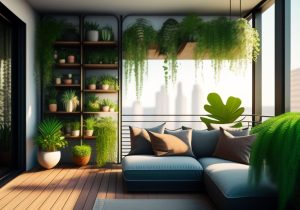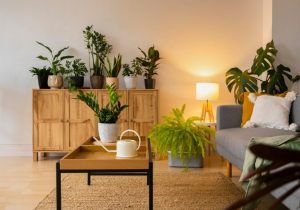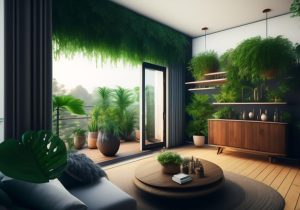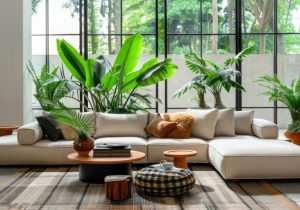With today’s fast and concretised world, the yearning for contact with nature has never been greater. That’s where biophilic design steps in—an approach integrating natural elements into our living spaces to foster a closer connection between humans and the natural environment. How do you recreate the feel of a lush forest or a serene beach in a compact apartment? How do you envisage living in a home that breathes life and serenity even when the space is at the very minimum?
The science behind biophilic design reveals that it is not a trend but an imperative. It is documented that elements of nature in our interiors could lower our stress levels, tap into our creativity, and raise well-being. However, working with small spaces becomes even more challenging since they count every inch. In this blog, we dive deeper into the philosophy of biophilic design and learn advanced strategies for how to harmoniously fit nature into compact spaces without giving up style and functionality.

Biophilic design isn’t just about adding a few plants to your home; it’s a holistic approach that considers how we interact with our environment on a fundamental level. The term “biophilia” was popularised by biologist E.O. Wilson, who described it as humanity’s innate tendency to seek connections with nature. In architecture and interior design, biophilic design draws from this concept to create spaces that reconnect us with the natural world.
Connection to Nature: Biophilic design aims to restore the connection between humans and nature, which is often lost in urban living. This includes incorporating natural light, plants, water, and organic materials into interior spaces.
Sustainability: Beyond aesthetics, biophilic design promotes sustainability by using eco-friendly materials and designs that reduce environmental impact. It aligns with the growing movement towards sustainable living, particularly in dense urban areas.
Human-Nature Interaction: The design should encourage interaction with natural elements—whether through physical touch, sight, or even sound. This interaction is key to reaping the psychological and physical benefits of biophilic spaces.
In small homes, the challenge is to incorporate these elements without overwhelming the room. It requires a delicate balance of creativity, resourcefulness, and an understanding of how each element contributes to the overall sense of well-being.

When space is limited, the plants you choose and where you place them becomes crucial. Biophilic design in small spaces requires strategic thinking—selecting the right plants that thrive indoors, utilising vertical space, and creating micro-environments that bring nature into every corner of your home.
Air-Purifying Plants: Opt for plants that do more than just look good; choose species known for their air-purifying qualities like snake plants, peace lilies, and spider plants. These are not only compact but also improve indoor air quality, making them ideal for small spaces.
Low-Light Plants: For areas with limited sunlight, plants like pothos, ZZ plants, and philodendrons are perfect. They thrive in low-light conditions and require minimal maintenance, making them a great choice for urban apartments.
Native Species: Incorporating native plants can help create a more sustainable and low-maintenance environment. These plants are adapted to the local climate and typically require less water and care.
Vertical Gardens and Green Walls: When floor space is scarce, think vertically. Vertical gardens or green walls can transform a blank wall into a lush, living artwork. These installations not only save space but also bring the benefits of nature indoors in a visually stunning way.
Innovative Planters: Use hanging planters, wall-mounted pots, or even ceiling-suspended terrariums to maximise plant life without taking up valuable floor space. These creative solutions allow you to incorporate greenery into unexpected places, adding layers of natural beauty to your home.

Natural light is one of the crucial ingredients of biophilic design. It is not just about lighting up spaces; it is more about relating to the rhythms of the natural world. In small spaces, the aspect of maximizing natural light can create a perceptual illusion of more considerable space, openness, and connection outwards and beyond.
Skylights and Large Windows: If it can’t be helped, put in skylights or make your present windows bigger in order to fill your space with natural light. These take a lot of investment in small spaces, but the change is quite dramatic compared to its feel—it gets brighter, more spacious.
Use glass doors or partitions instead of solid walls so that light will be able to enter every room. It will thereby add to the space that the room creates and at the same time brighten the entire house with light during daytime.
Sheer Curtains and Translucent Partitions: Allow the influx of natural light with sheer curtains rather than heavy drapes that block it. Translucent partitions will serve to section spaces without cutting off light, hence keeping the sense of openness and connectivity alive.
Reflective Surfaces: Attain further reflection of light within space by integrating a glass table, a big mirror, or maybe include some glossy tiles. Once more, it wouldn’t be so hard on the intensity of lighting and would lend a feeling of more liveliness to a space.
Smart Lighting Systems: Just like natural light, smart lighting systems designed to mimic the natural daylight cycle enhance the biophilic experience. They modulate the intensity and warmth of light gently through the day, further enforcing your body’s innate circadian rhythms and thus creating a more harmonious living environment.

Materials and textures are a major component of biophilic design. Natural materials like wood, stone, and organic textiles offer a haptic experience with nature that continues to further enrich the sense experience of a space.
Sustainable sourcing: Go for items made from reclaimed,bamboo, or cork. Most of these materials are really easy on the environment and bring that feeling of being natural or organic into space. For instance, a coffee table with a top made of reclaimed wood would add just another beautiful piece as a centerpiece while supporting a sustainable design ethos.
Sustainable and Durable: Try to use materials that are both sustainable and long-lasting, such as a jute rug, linen fabric, or stone countertops. These elements also bring the outdoors inside while promoting better health and an eco-friendly lifestyle.
Nature-Inspired Patterns: Add in some nature-inspired patterns, from leaf prints to floral designs, and even water-inspired motifs. You could use this in wallpapers, upholstery, or simply as decorative features throughout your spaces where organic shapes from the natural world find their embodiment within your interiors.
Organic Forms: Moving away from sharp and linear designs, lean toward organic forms when it comes to decor and furniture. Mimicking natural forms, curved lines and rounded edges bring a softer environment that is very inviting.
Layer different textures to create a variety of tactile experiences. Put a smooth stone tabletop, for instance, alongside a coarse jute rug and a soft woolen throw. This would present an interesting contrast in textures, creating a space that is not only more tactilely interesting but also visually exciting.
Balancing the modern and natural elements: Although natural materials warm up the space, one should be very careful about balancing the elements so that it does not look rustic or too earthy. Very sleek, minimalistic furniture with natural textures holds good elements in giving a contemporary feel of space without losing the bond with nature.

Biophilic design goes beyond the visual—it’s about the multisensory integration that speaks to all five senses. Through the consideration of sound, smell, and touch, an environment can both engage and support the well-being of an occupant.
Include sound: Sound is an important part of biophilic design. Consider adding some small indoor water features, such as a table fountain, to introduce calming water sounds inside the room. You also could consider hanging a few wind chimes or playing soft, nature-inspired music to enhance the effect and further create a calming ambiance.
A sense that has a big influence on mood and attitude. Think about natural, plant-based fragrances like lavender, eucalyptus, or sandalwood to get your space emanating calming, earthy olfactory vibes. Light up some scented candles, use an essential oil diffuser, or just have a bunch of fresh herbs in the kitchen in order to build that olfactory pathway back to nature.
Create a number of specific immersion zones in your home to deliver positive sensory experiences in a consistent way. For example, develop a reading nook with soft lighting features, tactile blankets, and the scent of fresh flowers, or put in a small meditation corner with a water feature and calming music.
Design the room with the integration of different materials of decor, examples include textured pads, fragrant plants, or artistic compositions inspired by nature. All this would make the environment look dynamic and alive, which triggers a relaxation feeling and enhances creativity.
Reducing stress and enhancing well-being: A sensory-rich environment reduces stress and stimulates the well-being of human beings. Carefully curating your sensory elements in your home could make your house look beautiful and, above all, be a sanctuary for nurturing human mental and physical health.

Indoor and outdoor spaces are fully integrated in biophilic design. This creates a literal dissolve of edges that separate your home from nature and makes the living environment open, light, and quite connected to the natural environment—a feeling important for even small homes.
Maximize small outdoor spaces: Make use of a tiny balcony or patio for additional square footage. Potted plants, vertical gardens, and the use of outdoor furniture coordinating with your interior design scheme will set up an interior/exterior connection. Use similar materials and colors both in and out to blur the barrier.
Sliding doors and floor-to-ceiling windows can provide one uninterrupted view from your indoors to the outdoors by installing sliding glass doors or floor-to-ceiling windows. Open ones therefore give free passage from the interior to the exterior, making a home look really big, much bigger than it is in reality, and integrated with nature.
Open-Air Spaces: If you have a balcony, patio, or yard, open the doors to fresh air and sounds that let in through the home space. This can give your space an instantaneous relatedness to the outside world and increase the biophilic experience.
Natural Pathways: Create a flow from your interior space to your outdoor area with natural pathways. These can be accomplished by using stepping stones, wooden decks, or even paths made of gravel to guide the transition—it feels like a continuous journey from inside to outside.
Green Balconies in Urban Apartments: Very few urban apartments have incorporated biophilic design, whereby small balconies have been converted into green spaces. With the addition of vertical gardens, potted plants, and comfortable seating, one is able to transform the place into a mini oasis of peace amidst the city.
Tiny Homes with Big Views: Many tiny homes have incorporated large windows and glass doors that expand out into the world. Opening onto big views, these homes often seem like so much more square footage than they actually are; that is, they provide a sense of space and freedom.

Here at Bonito Designs, we understand the nuances dealing with design for small spaces. Our professionally skilled team of designers shares a passion for proffering assistance in infusing the beauty and benefits of biophilia—bringing homes to life. We, from Bonito Designs, with our customized solutions, strike a balance between form and function, which, guaranteed, shall ensure your abode never serves as just another pretty place but actually is a place of nurturing.
Customised Design Solutions: We provide custom design services in favour of your space, lifestyle, and style. Our designers work hand-in-hand with you in the process of developing a biophilic design plan that suits your space most and brings the beauty of nature into the indoor area.
High Quality Material and Finishing: Bonito Designs assures you materials in a sustainable and environmentally friendly way which conform to the ideologies championed in biophilic design. That means from real wood to organic textiles—it is assured that every element your house comprises of, is picked and worked out professionally.
Indoor-Outdoor Integration: We specialize in creating seamless transitions between the indoors and the outdoors using design techniques that make your home feel larger, more open, and connected to nature.
On-Time Delivery and Professional Completion: With more than 300 designers on staff and an in-house manufacturing process, you can rest assured that your project will not only be of the highest quality but also delivered on time. We have a delivery guarantee of 90 days so that you can step into your brand new, enriching biophilic space just as you are.
ISO-Certified Excellence: The first interior design brand in the country to be ISO certified, Bonito means business when it comes to quality and safety standards to conform to, ensuring that your home is beautiful inside-out and long-lasting to last. Flexible EMI Options: We believe every spirit deserves a nature-inspired, beautiful home. Our flexible EMI offers go soft on your pocket and bring your interior design dream to reality.
Biophilic design is a method to bring elements of nature into built spaces for the well-being and connection of users with nature. It is important because it promotes mental and physical health, especially in urban settings.
Bring in the outdoors through vertical gardens, natural materials, and maximizing natural light. Strategic placing of plants and sensory elements, including sound and scent, can also contribute to a biophilic environment.
Consider the incorporation of air-purifying plants, reflective surfaces, or seamless transitions from interior to exterior with sliding doors or large windows.
Bonito Designs offers bespoke, high-quality design solutions to bring all the benefits of biophilic design into your home through expert designers and sustainable materials so you can create a nature-inspired space tailored to your needs.
Biophilic design has reduced stress, enhanced creativity, and improved mental and physical health by reinstating the connection that an individual has lost with nature through his or her living environments.
